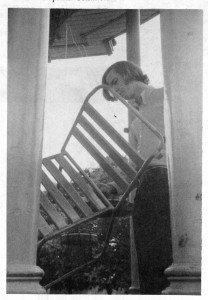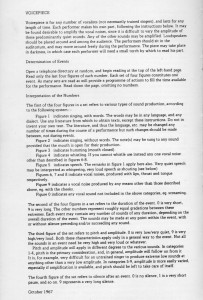We continue the Video Watch comparison of performances of John White’s Drinking and Hooting Machine. Click Variation I, Variation II and Variation III for previous entries. You may also like to check out the EMC Facebook page for June 6 and June 8 for comments on this series from the composer Paul Epstein. Another composer friend of the EMC, Oded Assaf, has commented on a previous entry in this blog, as well. Please feel free to get in touch!
Speaking of Facebook, a little while ago, the LA composer Sean McCann sent out a YouTube link for a performance of Drinking and Hooting Machine in the Powell Library Rotunda at UCLA. Marked ‘Hooting and Drinking Machine’ by the poster/filmmaker, it is a successful and rather beautiful performance. You can see it here:
There are several factors in this version that suggest that the performers may not stick strictly to the rules of the piece itself. First, the grouping is unclear: White specifically states that this piece is for four main groups of performers, with up to five sub-groups, making 4-20 distinct parts. White does not limit how many performers may play each part. Moreover, the actions requested in each part are different, but due to the instrumentation (bottles), the timbre is pretty close. And even if everyone played the same part, their choice of breath, ability to hold a note, and what constitutes a SIP, SWIG, or GULP differs. This is another reason that Drinking and Hooting Machine is so like Riley’s In C, which itself has only one part, and which performers move through the material at their own speed. But there’s another factor in this and other performances that is referred to by a person commenting on the YouTube upload. Bruno Ruviaro asks if they used the full score, as he had only been able to access the score excerpt in Nyman’s Experimental Music: Cage and Beyond. (Well, Bruno, we have a fix for you there — stay tuned!).
So, can a performance using only half a score be a legitimate performance? This reminds us of Christopher Hobbs’s piece Pretty Tough Cookie, which is built up from one figure in an internal horn part in Tchaikovsky’s Romeo and Juliet. That certainly is more Hobbs than Tchaikovsky in that one, and it’s designed that way. Half a Drinking and Hooting Machine actually destroys White’s random series and the system itself. But there is still an identity there that we can see as being Drinking and Hooting.
The UCLA performance is certainly White, and it’s a good one. Why? First, the acoustics in the Rotunda are gloriously resonant, sustaining the rather short breaths of the assembled masses (this is audience participation). And the simple fact that there are so many players solves the problem that appears early on in the Zeitkratzer video of silence appearing between hoots. The players in the UCLA video settle into longer hoots as the performance goes on, just like the Zeitkratzers do. But even though some performers hoot almost as fast as the Isle of Wight students in our first video (perhaps because of unfamiliarity with their instruments), the sound is always covered by other performers.
Was it universally liked? I think I heard the words, ‘Stop it, now!’ about 2 and a half minutes in. But what was absolutely lovely was the response at the end: joyous laughter, rather than the embarrassed laughter of the first video. They came, they drank, they hooted, and they enjoyed. What could be more fun? It’s almost like hanging out with White himself.
Right, that finishes this series on videos about John White’s Drinking and Hooting Machine, in its four variations. But next, we’re going to supply the theme itself. John White has agreed to allow the Experimental Music Catalogue to make Drinking and Hooting Machine — the official version published in the Scratch Anthology of Compositions — available on the web. This is coming soon, so keep watching, and of course, keep hooting!



